Welcome back to Week 37 in my weekly reports analyzing the Covid-19 pandemic and its effects on the country and higher education, and happy holidays to all. For those of you reading this on my blog, Off the Silk Road, I have also launched a newsletter, where these reports can be sent directly to your email each week. Click here to subscribe.
Last week, we shed light on a devastating round of hospitalizations and deaths and discussed the latest details on vaccine rollout. This week, we will examine the latest round of data before the holiday season and show how the Trump administration will fail to meet its goal of administering 20 million vaccine doses by the end of the year.
A national look
I’d like to begin this week’s report by wishing a very happy birthday to Dr. Anthony Fauci, who celebrated his 80th birthday on December 24. D.C. Mayor Muriel Bowser declared December 24 “Dr. Anthony S. Fauci Day” in the District and Dr. Fauci enjoyed the surprise of first responders singing him a happy birthday. We thank him for his service to our nation’s public health and the countless lives he has saved.
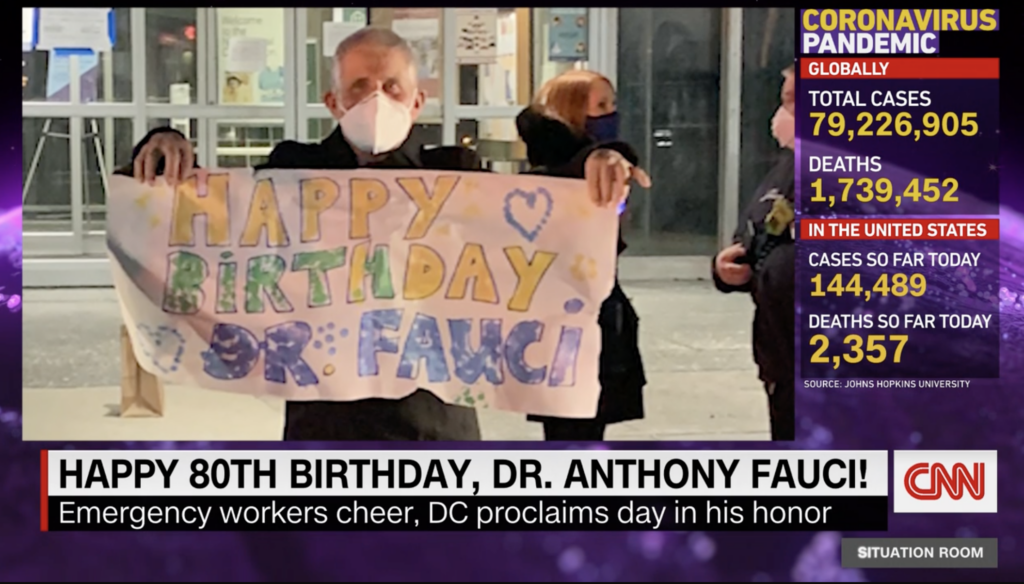
The United States has entered the holiday season at yet another breaking point, with record highs in hospitalizations and having not fully recovered from the Thanksgiving surge. It is only inevitable that Christmas and New Year holiday gatherings will lead to a surge in cases as 191,123 people passed through TSA checkpoints on Wednesday, more than the previous record set the Sunday after Thanksgiving. The U.S. has more Covid cases and deaths every 5 minutes than Taiwan has had all year. This past week, just five states constituted 40% of the nation’s cases: Arizona, California, Florida, Tennessee and Texas. Even earlier this week, December has already passed April as the deadliest month of the pandemic.
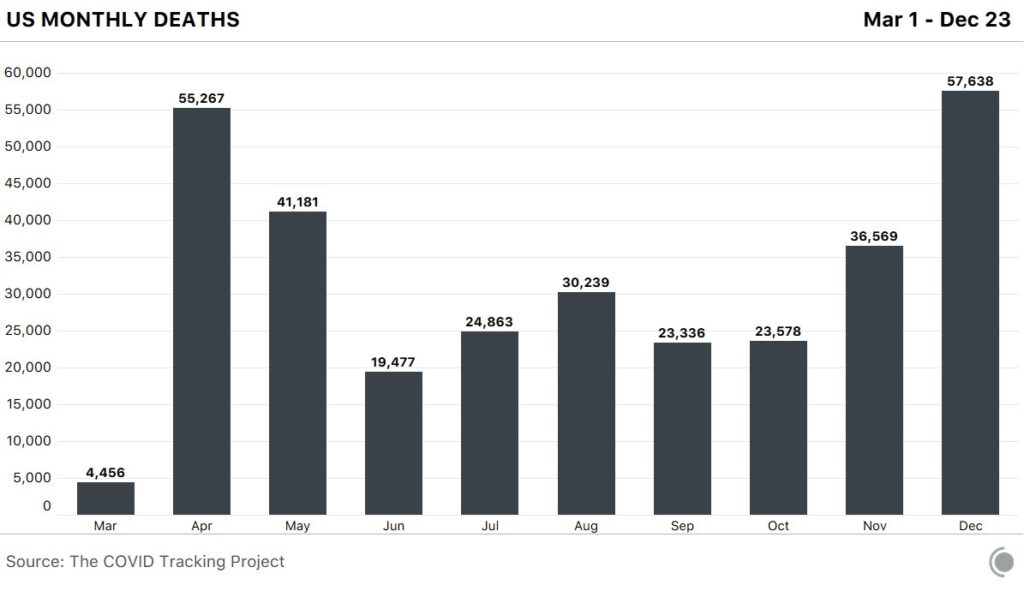
This week the U.S. has passed a sobering milestone — with over 330,000 recorded deaths from Covid-19, one in every 1,000 Americans has died this year from the coronavirus. This is the deadliest year in U.S. history, with all-cause deaths expected to top 3 million for the first time — due mainly to the coronavirus pandemic. The Institute for Health Metrics and Evaluation model at the University of Washington’s model has now projected 567,000 cumulative deaths on April 1, 2021.
Much of this week’s coronavirus discussion revolved around a new variant of the coronavirus, first detected in the UK. Viruses mutate all the time, and the best way to slow mutations is to lower the amount of virus in the community using the behaviors we all already know. Multiple countries have imposed travel restrictions on travelers from the UK, with the U.S. now requiring travelers to obtain a negative coronavirus test within 3 days prior to departure. According to British scientists in a study published earlier this week, researchers estimated that this new variant is 56% more contagious. While more study is needed to actually determine its effects on transmission, the researchers underscored the importance of a rapid vaccine rollout. It is highly likely that this variant is already circulating in the U.S. We are simply unable to detect it due to our lack of genomic sequencing. According to an analysis from The Washington Post, the United States ranks 43rd in percentage of cases sequenced among countries with more than 100 reported infections. Of the more than 18 million cases officially reported in the United States, just 51,212, or 0.3%, have been genetically analyzed for variants.
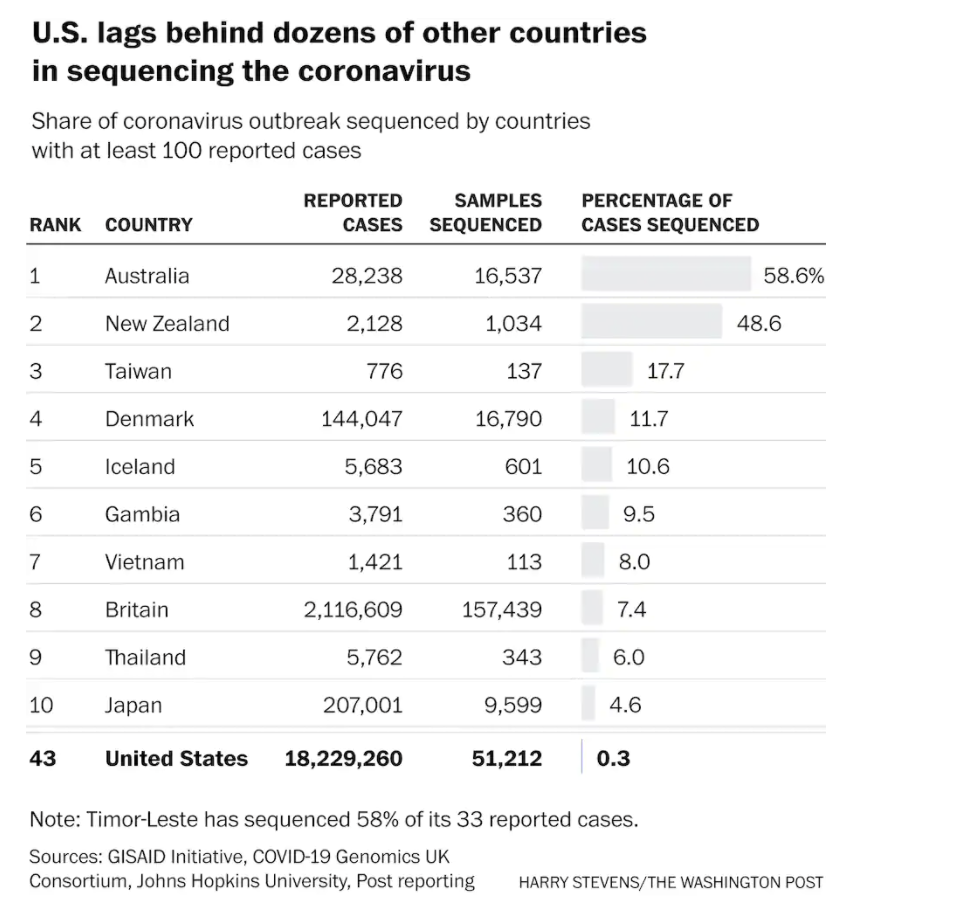
In addition to the usual science and infectious disease research, we must also devote part of this week’s discussion to disinformation around Covid-19. A new survey published by the Brookings Institution shows how misinformation spread on the internet and by politicians has distorted Covid-19 policies and behaviors. Democrats are more likely to correctly understand that Covid can be spread by people without symptoms and more accurately assess the overall mortality risk of Covid-19 as more severe compared to other common causes of death, such as influenza and automobile accidents. This is no doubt partially due to the president’s repeated efforts to downplay the pandemic and post inaccurate comparisons to other causes of deaths on Twitter. This week, misinformation superspreader-in-chief and former presidential pandemic advisor Scott Atlas penned an almost laughable op-ed in The Wall Street Journal, claiming that the media’s politicization of the pandemic (and not his deadly policies) has put Americans’ lives at risk. “The media has done its best to misinform the public with political attacks about who is to blame for this pain and misery even as it diminishes the great achievement of the new vaccines,” he wrote.
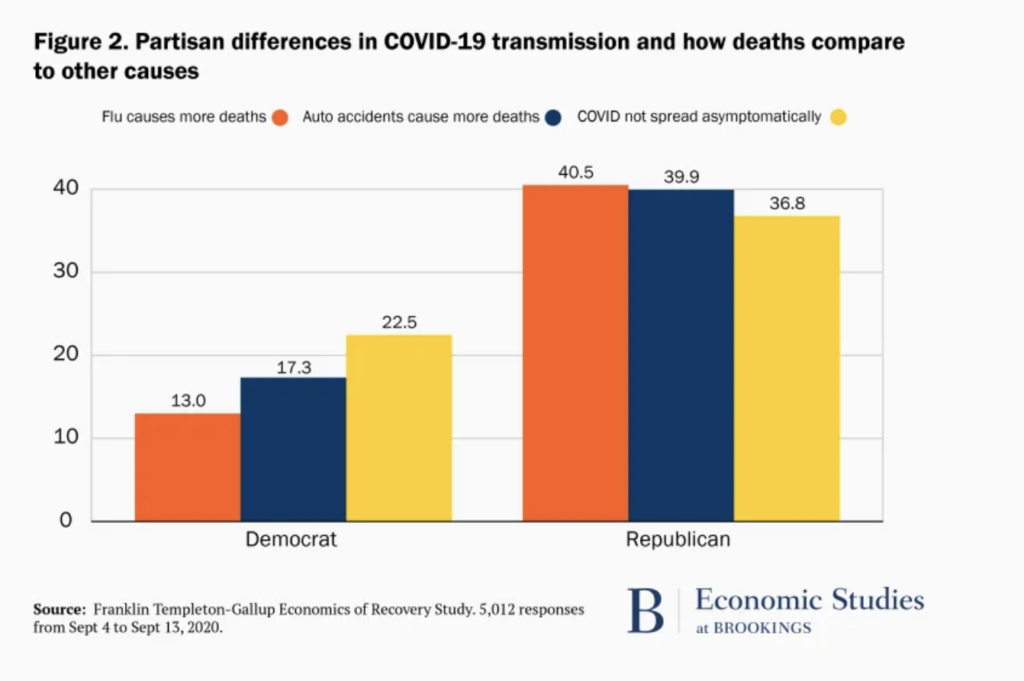
Let’s take a look at some of the latest scientific developments:
- An NIH-funded study found that pregnant women in their third trimester are unlikely to pass SARS-CoV-2 infection to newborns, with no maternal viremia, placental infection, or vertical transmission of SARS-CoV-2.
- A second wave has hit the African continent, with a variant similar to the one in the UK detected in South Africa.
- According to new estimates from Dr. Fauci and other scientists, it may take close to 90 percent immunity to bring the virus to a halt.
- A study published in JAMA found that all else equal, Covid-19 mortality in hospitals seems to be lower when the prevalence of Covid-19 in their surrounding communities is lower.
- A southern Oregon community was recently devastated by two coronavirus outbreaks that killed seven people and caused hundreds to quarantine fearing they had been exposed to the virus, according to The Washington Post.
- A CDC study of asymptomatic or mildly symptomatic individuals in South Korea found that 8 months after infection, antibody levels were still high.
- A study published in the Physics of Fluids found that mask-wearing and social distancing must be practiced in tandem, as masks would not offer complete protection to a susceptible person from a viral infection in close contact.
- A study published in JAMA of hospitalized patients in the VA system found that within 60 days of discharge, 27% of patients were readmitted to the hospital or died.
- According to survey results published in the International Journal of Nursing Studies with data from China, nearly all (99%) people wore a mask during the covid-19 pandemic, with most (73.3%) demonstrating high compliance with face mask use.
- A working paper from Michigan State University using data from Michigan and Washington estimated that while in-person schooling is not associated with increased spread of Covid in communities with low levels of pre-existing Covid cases, new cases do increase in communities with moderate to high pre-existing Covid rates and more in-person classes.
- In a new paper published in Science, Harvard epidemiologist Dr. Michael Mina and immunologist Dr. Kristian Andersen argue that there is not a one-size-fits-all approach for Covid-19 testing, and testing strategies can be used for different purposes.
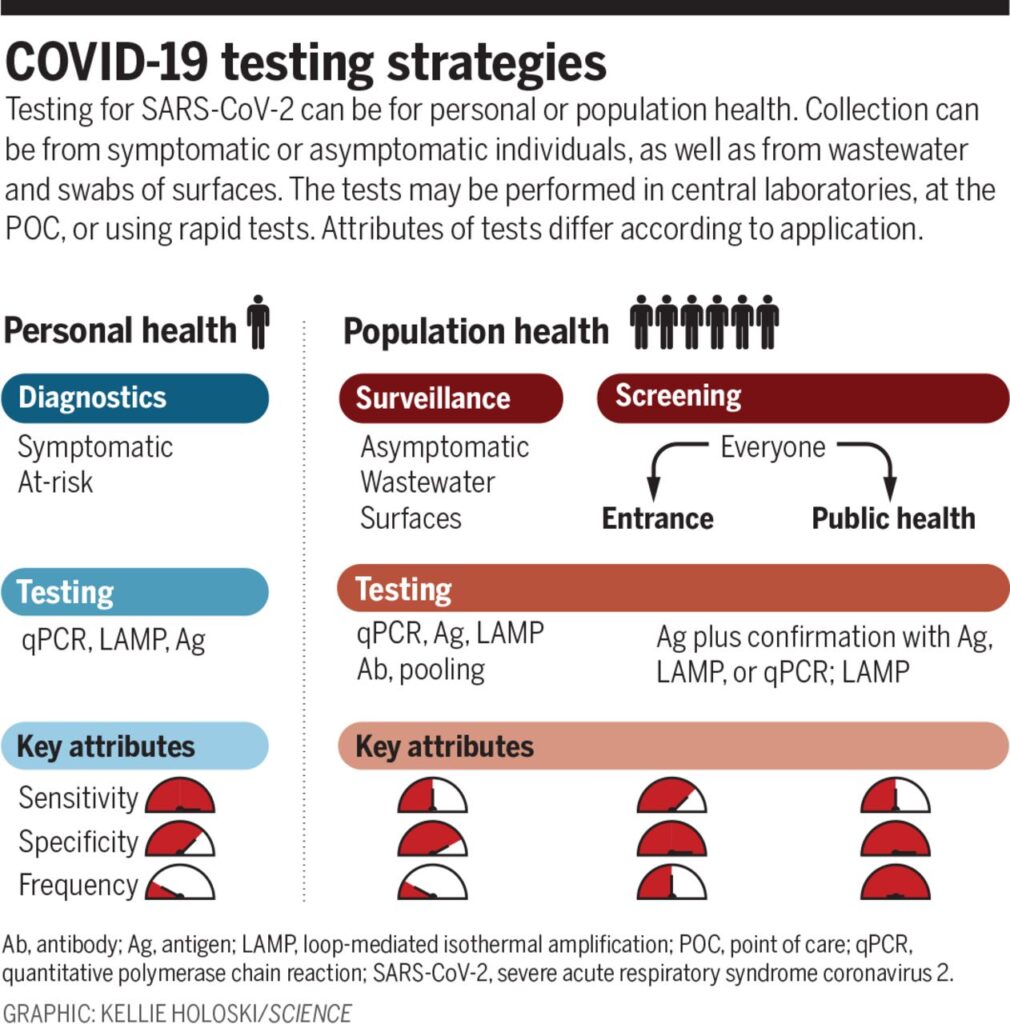
Finally, some updates on vaccines.
- The Trump administration and Pfizer announced a deal on Wednesday for an additional 100 million doses of vaccine by the end of July, with the agreement stipulating that the president invokes the Defense Production Act to help Pfizer get better access to around nine specialized products it needs to make the vaccine.
- Former CDC director Dr. Tom Frieden advocated for carefully designed “immunity passports” to help the economy reopen and allow vaccinated individuals to engage in certain activities.
- In a Sunday morning news release, the chief executive of AstraZeneca said that new data from its vaccine will show it has 95% efficacy and 100% efficacy against severe cases of Covid-19. Approval in the UK could be as early as mid-next week, though the full batch of data has not yet been released. If the data are true, it is a huge breakthrough because the AstraZeneca vaccine is cheap, does not require refrigeration and has been ordered in large quantities all over the world.
- Texas has broken with the CDC’s recommendations in vaccinating the elderly over police and teachers. More states may enact similar measures.
- Some polls show that vaccine skepticism is declining, partly because of the high efficacy rates in trials and the images of real people getting vaccinated.
- According to The New York Times, “Turkish officials announced Thursday that a vaccine from the Chinese company Sinovac has an efficacy rate of 91.25%, but the finding was based on preliminary results from a small clinical trial and none of the data was published in a journal or posted online.”
- USA Today published a great explainer of how the Pfizer and Moderna vaccines are transported from the factory to the distribution site.
- We must beware of the danger of “vaccine euphoria” — while there is light at the end of the tunnel, the tunnel is long and there will be many roadblocks.
- According to a CNN analysis, many of Chicago’s majority-Black and Latino Census tracts do not have a pharmacy, raising questions about equity in the distribution process. In the coming weeks, we will continue to examine questions of access.
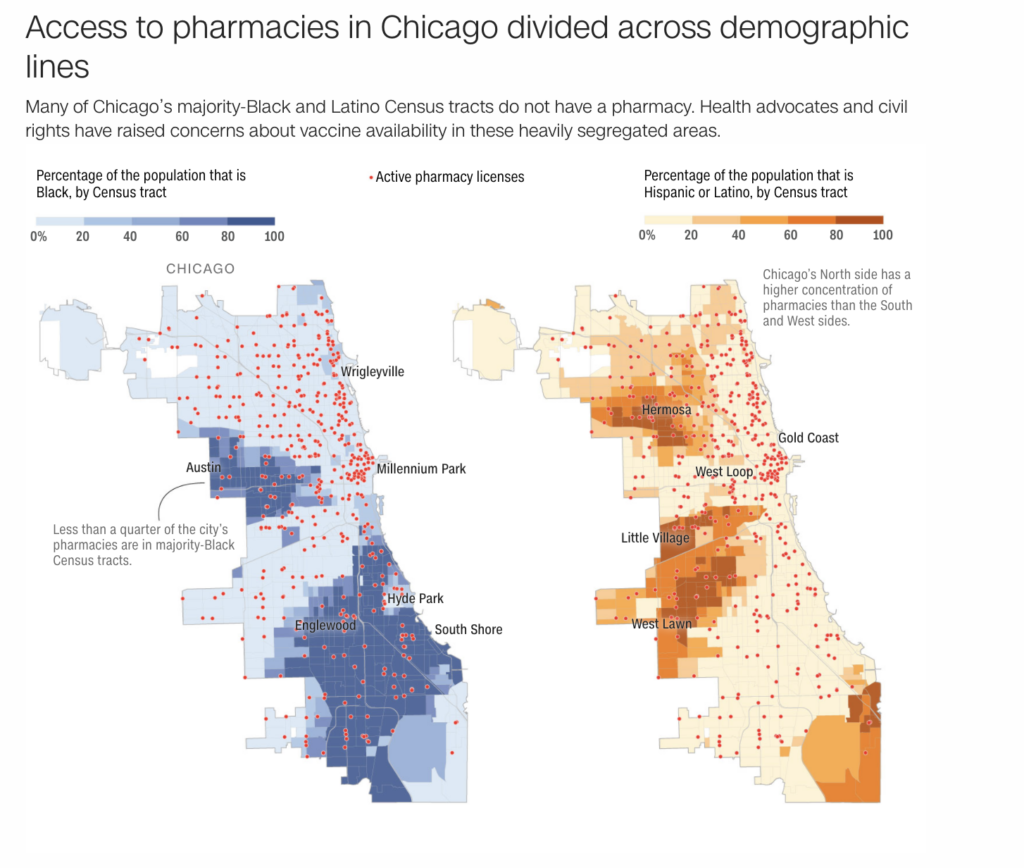
In short, the first steps of the nationwide vaccine rollout has been moderately chaotic, with 64 jurisdictions (states, territories and cities) each having a separate distribution plan and facing additional challenges. Cold chains, rural terrain and federal-state coordination are just some of the issues states have faced. Part of Operation Warp Speed’s “sales pitch” was that vaccine distribution would be run by generals from the U.S. military. “But it turns out that getting fuel, tanks and tents into war-torn mountainous Afghanistan is in many ways simpler than passing out a vaccine in our privatized, profit-focused and highly fragmented medical system,” New York Times columnist Elisabeth Rosenthal writes. The results already show issues with vaccine administration. According to the most recent release of data from the CDC, 9,547,925 vaccine doses have been distributed and 1,944,585 (20%) of those doses have been administered. This large discrepancy between doses distributed and administered is due to a number of factors, as Kaiser Family Foundation’s Josh Michaud illustrates: reporting lags (often 3-7 days from states), doses held for long-term care facilities and cold chain challenges. Despite these reasons, it is clear that the U.S. will not meet the 20 million doses administered the Trump administration promised by the end of the year. Around 20 million doses (most likely slightly less) will have been allocated to states by the end of the year; the country will fall short of 20 million shots in arms by December 31. The pace of vaccine administration is expected to pick up this week and we may shortly be able to get the first estimates of how many Americans are being vaccinated each day. You can track vaccine dose allocations, distributions and administrations for each vaccine jurisdiction at my Vaccine Allocation Dashboard here.
Let’s move on to our discussion of higher education.
Higher education
Here’s a roundup of this week’s higher ed news:
- Penn State is the latest school to begin the spring semester remotely and delay in-person classes to February 15.
- Nearly 1 in 5 UConn athletes tested positive for Covid-19 this semester, three times the rate for non-athlete students.
- Florida’s standout basketball player Keyontae Johnson has been diagnosed with acute myocarditis, underscoring the risk of Covid-19 on college athletes. This comes as the Duke women’s basketball team has ended its season early, citing coronavirus concerns.
- “By moving to Claremont, you will most certainly be contributing to an already disastrous spread, taking medical resources away from the local community,” two students at the Claremont colleges write. “For now, it is foolish, negligent and dangerous to return.”
- With strict protocols in place, UC-Santa Cruz students tested positive at lower rates than the community. We will be conducting further research to see if this is a pattern at other schools as well.
- The family of a U.S. teen jailed in the Cayman Islands for breaking Covid protocols has asked the Trump administration for help. American college student Skylar Mack traveled to the Cayman Islands to see her boyfriend in a jetski competition but did not isolate for the required 14 days.
- Wisconsin journalist Kelly Meyerhofer published an in-depth report on the University of Wisconsin-Madison’s fall semester, from the successes to the failures.
- Indiana University has released its spring semester testing plan. While I appreciate that the university has its own labs running to test all students on arrival, it is incredibly strange that students living on campus have to quarantine at home or at a hotel until their test results are returned. A “room quarantine” would enable greater adherence to the policy.
- A new study published in the Annals of Internal Medicine conducted a cost analysis on various interventions to curb infections on college campuses. Among students in the modeled sample university, mitigation strategies reduced Covid-19 cases from 3,746 with no mitigation to 493 with extensive social distancing and masks. These were further reduced to 151 total cases when all students were tested every 3 days.

The Good Stuff
Let’s roll the clips of the good stuff. In my usual tradition, I feature my favorite stories from the week. Here are my Top 10.
- “There is no option to get tired. There is no option to sit down and say ‘I’m sorry, I’ve had enough,’” Dr. Fauci said to The Washington Post, reflecting on his early days as a doctor in New York City. When fatigued, he recalled, he would tell himself: “I’m gonna dig deep and just suck it up.” “Which is kind of what he’s been advising the whole country,” The Washington Post reports. Dr. Fauci received autographed records from Barbra Streisand as a birthday gift with the following note: “Hope you have a Victrola, Love Barbra.”
- Some 700 foreigners in France who were exposed to the coronavirus as frontline workers will be put on a fast track for naturalization as a reward for their commitment during the pandemic.
- “I’ve trained for this. I’ve been in war, and this is absolutely worse. There are no borders in this war. There is no date when I know I’m going home,” Iraq war veteran and emergency room physician Dr. Cleavon Gilman told STAT.
- On a conservative-leaning island in the Chesapeake, a virus outbreak united instead of divided.
- New York Magazine’s Olivia Nuzzi continues to recount the strange story of Rudy Giuliani’s Four Seasons Total Landscaping press conference.
- South Carolina local journalist Joseph Cranney features his favorite pieces of local news from outlets in all 50 states.
- In a series of short films, The New York Times asked five people to celebrate the life of someone close to them who passed from the coronavirus.
- As the coronavirus vaccine is rolled out, older Americans recall memories from the polio vaccination era.
- A Virginia letter carrier rallied and made Christmas stockings for all 250 dogs on his route.
- Now nine months after the first round of state-imposed mitigation measures, the first babies conceived in quarantine are being born.
Conclusion
After a lengthy lag in data due to holiday reporting, it is inevitable that cases will rise following holiday gatherings, followed by increased hospitalizations and deaths. With December already the deadliest month of the pandemic, models point to daily deaths peaking in January (according to IHME, this number will be 3,890 deaths per day). “Despite the miracle of multiple vaccines being researched, authorized, and injected in record time, many Americans will still die of the coronavirus before they can get vaccinated,” emergency room physician Dr. Craig Spencer writes in The Atlantic. It is up to all of us to keep our neighbors healthy and alive so they can receive the vaccine in a number of months.
I’d like to thank all the student journalists with whom I have the pleasure of working. In the next weeks and months ahead, they will become vital in chronicling their colleges’ paths forward for the spring and beyond. Support their work by reading it.
My best to all for good health and wishing you a happy new year. This is the last newsletter of 2020; we’ll be back next Sunday, January 3, 2021.
Like what you see? Don’t like what you see? Want to see more of something? Want to see less of something? Let me know in the comments. And don’t forget to subscribe to the weekly newsletter!
For more instant updates, follow me on Twitter @bhrenton.


